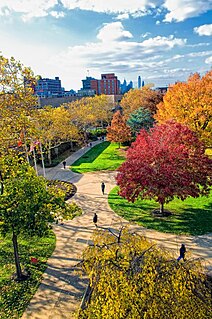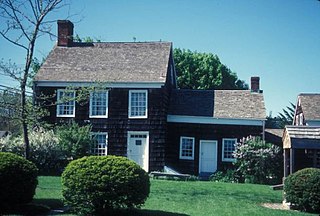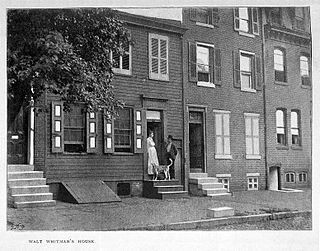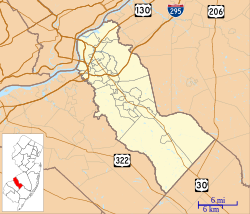
Rutgers University, officially Rutgers, The State University of New Jersey, is a public land-grant research university consisting of four campuses in New Jersey. Chartered in 1766, Rutgers was originally called Queen's College, and was affiliated with the Dutch Reformed Church. It is the eighth-oldest college in the United States, the second-oldest in New Jersey, and one of the nine U.S. colonial colleges that were chartered before the American Revolution. In 1825, Queen's College was renamed Rutgers College in honor of Colonel Henry Rutgers, whose substantial gift to the school had stabilized its finances during a period of uncertainty. For most of its existence, Rutgers was a private liberal arts college but it has evolved into a coeducational public research university after being designated The State University of New Jersey by the New Jersey Legislature via laws enacted in 1945 and 1956.

Camden County is a county located in the U.S. state of New Jersey. As of the 2020 U.S. census, the county's population was 523,485, an increase of 9,828 (1.9%) from the 2010 census, making it the state's 8th-largest county. Its county seat is Camden. The most populous place was Cherry Hill Township with 74,553 residents at the time of the 2020 Census, while Winslow Township covered 58.19 square miles (150.7 km2), the largest total area of any municipality.

Camden is a city in and the county seat of Camden County, New Jersey, United States. Camden is part of the Delaware Valley metropolitan area and is located directly across the Delaware River from Philadelphia, Pennsylvania. At the 2020 U.S. census, the city had a population of 71,791 and was ranked as the 14th most populous municipality in New Jersey. The city was incorporated on February 13, 1828. Camden has been the county seat of Camden County since the county was formed on March 13, 1844. The city derives its name from Charles Pratt, 1st Earl Camden. Camden is made up of over 20 neighborhoods. Geographically, the city is part of the South Jersey region.

South Jersey comprises the southern portion of the U.S. state of New Jersey located between the lower Delaware River and the Atlantic Ocean. The designation of South Jersey with a distinct toponym is a colloquialism rather than an administrative definition and reflects both geographical and perceived cultural differences from the northern part of the state with no official definition. Though definitions of South Jersey may vary, most of South Jersey is generally considered to be part of the Philadelphia metropolitan area, a.k.a. the Delaware Valley, that surrounds and includes Philadelphia, the seventh largest metropolitan region in the nation with 6.096 million residents as of 2020.

Rutgers University–Camden is one of three regional campuses of Rutgers University, New Jersey's public research university. It is located in Camden, New Jersey. Founded in 1929 as the South Jersey Law School, Rutgers–Camden began as an amalgam of the South Jersey Law School and the College of South Jersey. It is the southernmost of the three regional campuses of Rutgers—the others being located in New Brunswick and Newark. It is classified among "R2: Doctoral Universities – High research activity".

Cooper Street–Rutgers University station is a station on the River Line light rail system, located on Cooper Street in Camden, New Jersey, near the Rutgers–Camden campus. The southbound (westbound) platform is located west of 2nd Street while the northbound (eastbound) platform is east of 2nd Street in the Cooper Grant neighborhood.
Nicholas Anthony Virgilio was an internationally recognized haiku poet who is credited with helping to popularize the Japanese style of poetry in the United States.

Wilson Eyre, Jr. was an American architect, teacher and writer who practiced in the Philadelphia area. He is known for his deliberately informal and welcoming country houses, and for being an innovator in the Shingle Style.
Harleigh Cemetery is a historic rural cemetery located in both Collingswood and Camden, New Jersey. Harleigh Cemetery and Crematorium is one of the oldest cemeteries in New Jersey. Named Camden County Veterans Cemetery in 2007, the current president is Louis Cicalese. Harleigh cemetery is over 130 acres (0.53 km2) of lush mature grounds situated on the Cooper River a short drive from Philadelphia. The cemetery has been listed on the New Jersey Register of Historic Places since 1995.

The Walt Whitman Birthplace State Historic Site is a state historic site in West Hills, New York, listed on the National Register of Historic Places. The site preserves the birthplace of American poet Walt Whitman.

The Walt Whitman House is a historic building in Camden, New Jersey, United States, which was the last residence of American poet Walt Whitman, in his declining years before his death. It is located at 330 Dr. Martin Luther King Jr. Boulevard, known as Mickle St. during Whitman's time there.

Glendale Methodist Episcopal Church is a historic church at 615 Haddonfield-Berlin Road, at the junction with White Horse Road, in the Glendale section of Voorhees Township, Camden County, New Jersey, United States. It was added to the National Register of Historic Places on August 4, 1995 for its significance in community planning, development, and education from 1855 to 1920. At the time of its construction, the village of Glendale was impacted by the train station stop of Ashland on the Camden Atlantic Railroad. Because of the railroad, Philadelphians and shore villagers came to trade and do business.

Joseph Cooper House is located in Camden, Camden County, New Jersey, United States. The house was built in 1695 and added to the National Register of Historic Places on March 14, 1973, for its significance in architecture. A fire, about 2005, destroyed the roof. The ruins of the building are planned to become a pavilion in the surrounding park.

The Camden Free Public Library Main Building is the first former main library of the Camden, New Jersey public library system. Designed by Herbert D. Hale and Henry G. Morse, the building was constructed with a grant from the Carnegie Corporation and opened in 1905. It closed in 1986 with the relocation of the library's main branch to the former South Jersey Gas, Electric and Traction Company Office Building. In 1992, the building was placed on the state and national registers of historic places. The building has fallen into state of serious disrepair. In 2003, funding was found for its stabilization, with the hope that it would be preserved and re-used.
The Perth Amboy Public Library is the free public library in the city of Perth Amboy, New Jersey, located at 196 Jefferson Street.

The Camden Waterfront, also known as the Central Waterfront, is a commercial and entertainment district in Camden, New Jersey, on the Delaware River south of the Ben Franklin Bridge and north of Port of Camden.

Cooper-Grant is a neighborhood located in the northwestern part of Camden, New Jersey. According to the 2000 U.S. Census, the neighborhood has a population of 838. The neighborhood is situated near the Benjamin Franklin Bridge and Rutgers University–Camden. It is served by the Cooper Street – Rutgers University River LINE station. The neighborhood is home to the Cooper-Grant Historic District which includes 93 buildings spread over 250 acres. Cooper-Grant is considered one of the city's contemporary residential success stories. It has a relatively low-crime rate and many residents are college-educated professionals and students.

The statue of Peter Pan is a 1912 bronze sculpture of J. M. Barrie's character Peter Pan. It was commissioned by Barrie and made by Sir George Frampton. The original statue is displayed in Kensington Gardens in London, to the west of The Long Water, close to Barrie's former home on Bayswater Road. Barrie's stories were inspired in part by the gardens: the statue is at the place where Peter Pan lands in Barrie's 1902 book The Little White Bird after flying out of his nursery. Six other casts made by Frampton have been erected in other places around the world.

Glassboro is an inactive train station in Glassboro, New Jersey which served passengers from 1863–1971. Its station house was restored c. 2015. It is located at the edge of the Rowan University campus. Listed as the West Jersey Rail Road Glassboro Depot, it was added to the National Register of Historic Places on April 14, 2020, for its significance in architecture and transportation.




















